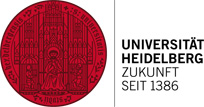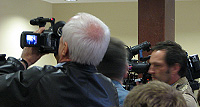Why Stellar Heavyweights Flicker like a Light Bulb on the Blink
9 March 2010
Stars are born when huge masses of gas collapse. As time passes, the new celestial body begins to shine and destroys the gas cloud surrounding it. Oddly enough, this is not necessarily the case with massive “heavyweights”. As astrophysicists at Heidelberg University have established, they tend to flicker more like a light bulb on the blink. With their simulation-based calculations, the scientists have made a substantial contribution to the understanding of the structure of gas clouds around massive stars and, in so doing, have solved a mystery that has puzzled astronomers for 20 years. The results of their work have now been published in the Astrophysical Journal.
Within interstellar gas clouds – the “cradles” of new stars – clumps form that subsequently collapse under their own gravity. At the centre of the clouds, density and temperature continue to increase until hydrogen can finally begin to combust to form helium. A new star is born. The Heidelberg astrophysicists are investigating the processes associated with star formation, notably in connection with stars ten to a hundred times larger than the sun, the first to light up and “illuminate” the cosmos after the Big Bang.
In massive stars, hydrogen combustion begins while they are still ingesting gas from their immediate environment. The stellar radiation should heat up the infalling gas and “blow it away”, a process that would greatly impede, if not completely halt, further star growth. Computer simulations devised at the Institute of Theoretical Astrophysics at the Centre for Astronomy of Heidelberg University (ZAH) have now been used to investigate the interaction between inflowing gas and a stellar radiation more closely.
In their models, the scientists working with Thomas Peters have for the first time taken into account the effect of ultraviolet radiation in a young celestial body. This radiation leads to the development of regions of ionised hydrogen around the massive star, so-called H II regions, which can be directly observed with a telescope and have been a mystery to astronomers for over 20 years. For example, the measured H II regions are much smaller than expected, but no convincing explanation has yet been advanced for the mechanism that hinders their growth.
Thomas Peters’ computer-based simulations now supply an explanation. They show that interstellar gas does not fall uniformly onto the star but forms thread-shaped condensations called filaments. These filaments are highly efficient in shielding the gas behind them from the star’s ultraviolet rays. The shadows they cast keep the H II region from expanding symmetrically around the star. Instead, they cause it to shrink at the shielded locations, making the H II region flicker like a light bulb on the blink.
These investigations also explain why H II regions look different. The various morphologies of the ionised gas regions originate randomly as a result of the current flow field and are highly dependent on the viewing angle. Accordingly, one and the same H II region can look like a shell from one angle and resemble a comet from another. Another reason why Thomas Peters’ findings are so important is that up to now the extent of an H II region has been taken as a measure for the age of a star. The simulations indicate that there is in fact no direct connection between extent and age as long as gas accretion is taking place. In the case of massive stars, this process continues almost throughout their lifetimes.
Original publication
Thomas Peters, Robi Banerjee, Ralf S. Klessen, Mordecai-Mark Mac Low, Roberto Galvan-Madrid, Eric R. Keto, HII-Regions: Witnesses to massive star formation. The Astrophysical Journal 711: 1017-1028, 2010 March 10, doi:10.1088/0004-637X/711/2/1017
Note for news desks
A digital photo is available from the Press Office.
Contact
Dr. Guido Thimm
Centre for Astronomy
phone: +49 6221 541805
thimm@ari.uni-heidelberg.de
Communications and Marketing
Press Office, phone: +49 6221 542311
presse@rektorat.uni-heidelberg.de

